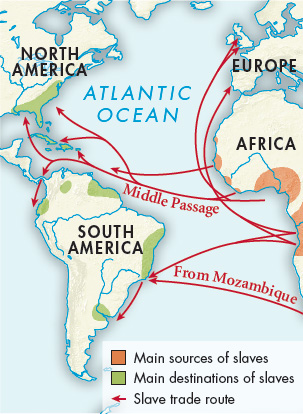Sugar and Early Transatlantic Slavery
As Portuguese explorers began their voyages along the western coast of Africa, one of the first commodities they sought was slaves. In 1444 the first ship returned to Lisbon with a cargo of enslaved Africans. While the first slaves were simply seized by small raiding parties, Portuguese merchants soon found that it was easier to trade with African leaders, who were accustomed to dealing in slaves captured through warfare with neighboring powers. From 1490 to 1530 Portuguese traders brought between three hundred and two thousand black slaves to Lisbon each year.
In this stage of European expansion, the history of slavery became intertwined with the history of sugar. Originally sugar was an expensive luxury that only the very affluent could afford, but population increases and greater prosperity in the fifteenth century led to increasing demand. The establishment of sugar plantations on the Canary and Madeira Islands in the fifteenth century testifies to this demand.
Sugar was a particularly difficult crop to produce for profit. Sugar cultivation was extremely labor intensive and, because sugarcane has a virtually constant growing season, there was no fallow period when workers could recuperate. The demands of sugar production were increased with the invention of roller mills to crush the cane more efficiently. Yields could be augmented, but only if a sufficient labor force was found to supply the mills. Europeans solved the labor problem by forcing first native islanders and then enslaved Africans to perform the backbreaking work.
The transatlantic slave trade began in 1518 when Spanish king Charles I authorized traders to bring African slaves to New World colonies. The Portuguese brought the first slaves to Brazil around 1550; by 1600 four thousand were being imported annually. After its founding in 1621, the Dutch West India Company transported thousands of Africans to Brazil and the Caribbean, mostly to work on sugar plantations. In the late seventeenth century, with the chartering of the Royal African Company, the English got involved in bringing slaves to Barbados and other English colonies in the Caribbean and mainland North America.

Before 1700, when slavers decided it was better business to improve conditions, some 20 percent of slaves died on the voyage from Africa to the Americas.4 The most common cause of death was dysentery induced by poor-quality food and water, lack of sanitation, and intense crowding. On sugar plantations, death rates among slaves from illness and exhaustion were extremely high, leading to a constant stream of new shipments of slaves from Africa. Driven by rising demands for sugar, cotton, tobacco, and other plantation crops, the tragic transatlantic slave trade reached its height in the eighteenth century.